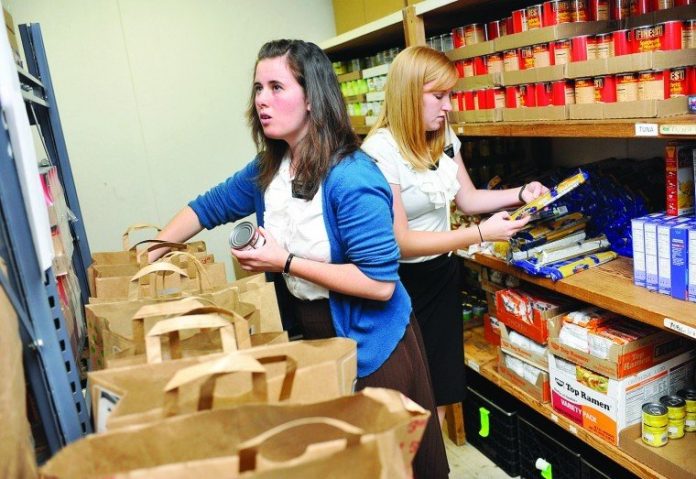As the nation struggles to climb out of a deep economic
recession that has shoved a record number of families into poverty,
a growing segment of Morgan Hill’s population has had to make
significant household spending cuts and rely increasingly on the
generosity of the community.
As the nation struggles to climb out of a deep economic recession that has shoved a record number of families into poverty, a growing segment of Morgan Hill’s population has had to make significant household spending cuts and rely increasingly on the generosity of the community.
Judi Jetson has done this with undying energy while surrounded by her family. She lives with her three daughters, who are in their 20s, her father, and three small grandchildren on Monterey Highway in north Morgan Hill. They feed the entire household of eight on a monthly income of $2,000 – “way less than last year,” Jetson said, and way less than what authorities say is the bare minimum needed to survive. According to the U.S. Census Bureau, in 2010 the poverty line for a family of four in America was $22,314.
A truck driver for more than 20 years, Jetson had to take some time off to care for her father, who suffers from dementia, and her three grandchildren, the oldest of whom is 4.
Her daughters have part-time jobs – two at a restaurant and one at a crafts store in San Jose – that pay the bills, which seem to be climbing higher.
“I make sure everybody’s fed, and OK,” she said one recent afternoon outside St. Catherine Church’s Reach Out Food Pantry.
The family moved to Morgan Hill from Gilroy in February, into a more affordable home. Jetson gave up her car to cut down on expenses.
She has recently started looking for a part-time job driving a truck, but she hasn’t had much luck even after applying at more than 300 places in the Bay Area, she said.
“That’s my big hurdle, trying to do what I love for a living,” Jetson said. She’s also worried about her own medical ailments which have worsened lately.
The rising cost of car insurance and fuel have been among the biggest financial burdens for Jetson and her family since the recession started. The holidays will be lean, with only the small kids likely to receive Christmas presents.
They buy their clothing from the Salvation Army, and collect unwanted furniture, and even an outdoor play structure, from nearby residents to use in their home. They peruse Craigslist classified ads for toys being given away for the children. They give back, too – “If we can’t use it, I’ll give it away,” Jetson said.
If it wasn’t for the food pantry, they wouldn’t have enough food for everyone to eat, she said.
For Jetson, though, the value of having her family with her is infinite.
“Times are real tough, but once the family is together, and we’re all helping each other out it’s better,” Jetson said. “Family is the most important thing for me.”
Safety net needs climb
The Reach Out Food Pantry, located in a trailer in the parking lot behind St. Catherine Church, serves “between 400 and 450 families” each month, according to coordinator Fran Hendrickson. About three years ago, it served about 300 families.
“Rents have gone sky-high, a lot of people are working part-time instead of full-time, and construction people are coming in, completely out of work,” Hendrickson said, alluding to those formerly employed in the once-booming industry that plummeted – locally and nationally – starting in 2008.
The number of families served by Reachout and other food pantries supplied by Second Harvest Food Bank of Santa Clara and San Mateo counties has leveled off since last year.
Since 2007, however, the number of people fed by Second Harvest in both counties has jumped by 48 percent, according to Second Harvest spokeswoman Caitlyn Kerk.
The two-county food bank supplies other help centers in Morgan Hill, including the People That Care food pantry at Crossroads Christian Center and the Brown Bag program for senior citizens at Advent Lutheran Church. Through these and other services, the nonprofit serves about 3,474 families in Morgan Hill.
The Reach Out and People That Care food pantries distribute food according to income limits and residency requirements set by Second Harvest. Clients receive one box of food per month, though they can get bread at the centers more frequently.
At Crossroads, the food pantry has “just about doubled” its client load in the last four years, according to director Sandra Cagle. It now serves about 150 households each month.
Second Harvest also donates food to Community Solutions, which helps victims of domestic violence and child abuse, as well as poor patients in need of mental health services.
While Community Solutions is not set up as a charitable giving organization, the staff there has seen a growing number of its clients suffering from “severe poverty,” according to director of development Lisa DeSilva.
“We’re seeing more clients lacking many of the very basic needs of daily life – food, hygiene, detergent, diapers – things you need day to day,” DeSilva said. Through their annual holiday giving drive, some clients who used to donate are now the receivers of good will. “People are really bereft of the basic necessities of life.”
Community Solutions often directs such clients to other services such as the food pantries, DeSilva said. They often provide clients with gift cards to grocery stores which have been donated to the agency, and sometimes even the staff digs into their own pockets to help those in urgent need.
“Poverty makes any situation worse. When people are literally worried about how to feed their family, it’s very difficult to focus their attention on positive parenting skills and improving communication (for example),” DeSilva said.
Poverty ranks expand
Santa Clara County, now and historically, fares better than most of the rest of the country when it comes to overall poverty. Countywide, 7.6 percent of the population lived below the poverty line in 2010, according to the Census. The median household income in this county was $88,525.
In September, the Census Bureau published an alarming report stating the national median household income fell to the lowest level since 1996, and the national poverty rate of 15.1 percent is the highest since 1993.
In the Bay Area, however, federal income standards are a moot point because the cost of living is higher than most other places in the U.S., according to the Insight Center for Community Economic Development. That nonprofit agency calculates the “self-sufficiency standard,” the minimum income needed for families to survive in specific states and counties.
For 2011, the self-sufficiency standard for a two-adult household with two young children in California is $63,000. That’s up from $53,000 in 2008, according to Insight.
That rise is attributed to “significant increases” in child care (22 percent), health care (27 percent), and taxes (29 percent) since 2008, according to a press release from the center. In Santa Clara County, a single parent raising two children needs to make $37 per hour in order to make ends meet.
Households cutting costs
Extended families living in one household – often having recently moved in together out of financial concerns – are common clients at the food pantry.
Alicia Duenas, 42, picked up a box of food at St. Catherine recently. She lives with her husband, their 14-year-old daughter, 11-year-old son and her parents, who are unemployed.
The couple and their kids moved in with the grandparents about four years ago, to cut down on housing costs, she said in Spanish. They’ve been going to the food pantry once a month for about the last year.
She works at a local fast-food restaurant where business has slowed down in recent months, resulting in a reduced work schedule for Duenas. Her husband works at another fast-food restaurant in Morgan Hill.
The food pantry supplies them with bread, eggs, cereal, vegetables, canned foods and other staples. “It helps a lot,” Duenas said.
Some of Morgan Hill’s lower-income residents have always had trouble climbing out of their financial rut, often due to factors beyond their control. Denise, 54, who declined to provide her last name, broke her back in three places in an auto collision with a drunken driver more than 15 years ago. “Unemployed and disabled,” Denise’s rent has gone up $75 a month, and her Social Security benefits have been cut each of the last two years.
Adding salt to the wounds, the state and county the last two years have cut budgets for services intended to keep lower-income residents afloat.
“The governor’s budget crunch – he decided to take money away from the poorest people,” Denise said. “They never did really explain why.”
– 7.6 percent: Santa Clara County residents living below thepoverty line, 2010
– 9.1 percent: National unemployment rate
– 13.3 percent: Morgan Hill unemployment rate
– 15.1 percent: Americans living below the poverty line,2010
– 3,474: Families served by food pantries in Morgan Hill
– $22,134: Federal poverty line for a family of four, 2011
– $63,000: “Self-sufficiency standard” for a family of four(including two small children) in California, 2011
– 46.2 million: American population living below the povertyline, 2010
Sources: U.S. Census Bureau, Insight Center for CommunityEconomic Development, Second Harvest Food Bank, California EconomicDevelopment Department














